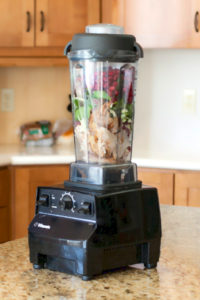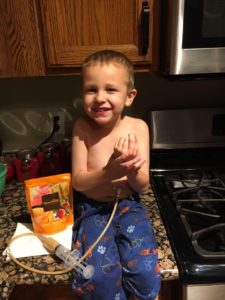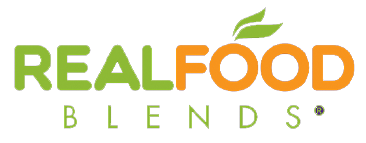Clinical Research

Blenderized Diet Research
A growing number of clinical studies and presentations support the use of real food for people with feeding tubes. Below is a list of blenderized diet studies from medical professionals, which we will continue to update as more studies are released. Our hope is that this information can assist people with feeding tubes receive physician support and gain insurance coverage for our meals and make it easier for medical professionals to proactively suggest real food for people with tubes by having proven, documented reasons that people with feeding tubes can benefit from blenderized diets.

Children’s Hospital of Michigan / Wayne State University Medical School (Presented at NASPGHAN, 2014)
Conclusion: The pureed diet by GT is an alternative diet that is well received by families of patients. The pureed diet can improve the gagging / retching, oral tolerance, weight velocities, and stooling habits. Adverse effects of the pureed diet are limited.
Mayo Clinic, 2015
“BTF resulted in significantly less reported nausea, vomiting, bloating, diarrhea, and constipation compared with commercial EN. Conclusions: This is the first study to evaluate BTF use in an adult HEN population. More than 50% of our patients used and approximately 80% expressed a desire to use BTF if provided with adequate information.”
The Hospital for Sick Children and University of Ottawa
Conclusion: Initiation and maintenance of BTFs is not only feasible in a medically complex pediatric population but can also be associated with improved clinical outcomes and increased intestinal bacterial diversity.
The Hospital for Sick Children and University of Toronto (Presented at NASPGHAN, 2015)
University of Cincinnati College of Medicine, 2011
Children’s Hospital of Orange County (Presented at NASPGHAN, 2015)
Patricia Savino, MBA, RD, National Academy of Medicine, Colombia, 2017
Boston Children’s Hospital, 2019
Children’s Hospital of Los Angeles, 2019
The Johns Hopkins School of Medicine, 2019
STUDY
LOCATION
SOURCE
STUDY OBJECTIVE
PATIENTS IN STUDY
STUDY HIGHLIGHTS
Cincinnati Children’s Hospital
Journal of Parenteral and Enteral Nutrition, May 2011, Pentiuk, S. et al.
Children with feeding disorders requiring Nissen fundoplication continue to exhibit gagging and retching following gastrostomy feedings. This study used a “pureed by gastrostomy tube” (PBGT) diet in an attempt to treat these symptoms and provide adequate nutrition and hydration.
Children post- fundoplicaton surgery with symptoms of gagging and retching with gastrostomy feedings. Average age 2.85 years old, n=34.
52% of participants had a 76%-100% reduction in gagging and retching. Twenty-four children (73%) were reported to have a ≥ 50% decrease in symptoms. No child had worsened symptoms. 57% of children were reported to have an increase in oral intake. The higher viscosity of the feedings may be one reason why gagging and retching decreased.
Mayo Clinic
Nutrition in Clinical Practice, July 2015, Hurt, R. et al.
There are limited resources available for patients interested in BTF, and studies evaluating safety and effectiveness are limited. The purpose of the present cross-sectional study was to determine the BTF prevalence and frequency of use in adults receiving HEN.
Adult enteral patients over the age of 18 and prescribed commercial tube feeding. n=54.
55.5% of patients used Blenderized Tube Feeding (BTF) in addition to enteral prescription and approximately 80% expressed a desire to use BTF despite being prescribed commercial enteral formula. Of those that used BTF, 80% of patients were able to maintain goal body weight on blenderized enteral with improved tolerance as evidenced by significantly less nausea, vomiting, bloating, diarrhea, and constipation compared with commercial formula.
The Hospital for Sick Children
Journal of Parenteral and Enteral Nutrition, January 2018, Gallagher, K. et al.
To evaluate the feasibility of using BTFs in a medically complex pediatric population and assess their impact on clinical outcomes, as well as the microbiota.
G-tube patients with an average age of 3.4 years. More than 75% of calories from enteral feedings. 45% of patients on elemental or semi-elemental formulas prior to being transitioned to a blenderized enteral diet. n=22.
Prevalence of vomiting decreased from 76% to 53% when transitioned to blenderized enteral feeding. Gagging and retching decreased from 82% to 47% and use of acid-suppressive agents significantly decreased when transitioned to Blenderized Tube Feeding (BTF). Caregivers unanimously indicated they would recommend BTF. All patients on elemental or semi-elemental diet tolerated BTF. Microbiome samples for those using BTF showed improved bacterial diversity and richness in stool samples.
Institute for Neuro-rehabilitation Research
Clinical Nutrition, January 2018, Schmidt, S., et al.
To study the effect of tube feeding with natural foods in reducing the number of fluid stool evacuations and diarrhea in critically ill neurological patients.
Patients who had suffered ischemic stroke, intracerebral hemorrhage, traumatic brain injury, or hypoxic brain damage and required enteral nutrition. n= 118.
Tube feeding with natural based food was effective in reducing the number of watery defecations and diarrhea in long term tube-fed critically ill neurological patients when compared to those fed with standard tube feeding.
Blenderized Gastrostomy Feeding (BGF) Enhances Enteral Tolerance in Children With Short Bowel Syndrome (SBS)
The Children’s Hospital at Montefiore
Poster presentation, October 2019, Thompson, J., et al.
To determine if a complex diet would enhance enteral tolerance by several potential mechanisms, including increased transit time, alterations in microbiome, and enhanced intestinal adaptation.
Children ages 4 months-6 years who were transitioned from elemental amino acid formula to blenderized gastrostomy feed. n=17.
The researchers hypothesized that a [whole food] diet would enhance enteral tolerance. Blenderized Gastrostomy Feeding (BGF) was well tolerated by children with short bowel syndrome (SBS). Stool frequency and stool consistency all improved both at 1 month and 6-8 months after BGF was started. BGF appears to enhance enteral tolerance and new food acceptance in SBS patients. At the start of the study, 8/17 children were exclusively G-tube fed and at 6-8 months after starting BGF, all 8 were taking oral feeds. After starting BGF, patients using parenteral nutrition (PN) were also able to decrease their calories needed through PN.
These studies used Real Food Blends with their subjects as a commercial blenderized diet product.
Boston Children’s Hospital
The Journal of Pediatrics, October 2018, Hron, B., et al.
To determine whether clinical and patient-reported outcomes differ in children receiving blenderized diets compared with conventional formula.
Children aged 1-18 years receiving blenderized diets vs conventional formula via feeding tube. n=70.
Rates of total visits to the emergency department (ED), total admissions, and respiratory-related admissions per year were significantly lower in participants receiving blenderized diets. Visits to the ED decreased by 43%, hospital admissions decreased by 53%, and there was a 67% reduction in respiratory related admissions. Researchers theorized that increased viscosity, improved nutrient profile, and increased dietary diversity led to these results.
Children’s Hospital of Los Angeles
Poster presentation, October 2019, Ellen McCloy, MS, RD, CNSC
The objective of this ongoing study is to provide a novel, meal-based BTF product (Real Food Blends) to children requiring dialysis.
Pediatric enteral patients with kidney disease who were failing their current tube feeding regimen and/or their parents had a preference for blenderized feeds. n=5.
Five pediatric patients (1 peritoneal and 4 hemodialysis) were put on a combination of RFB and traditional renal formula for at least 6 months. One patient was able to discontinue Zofran and ranitidine. One patient was able to discontinue formula treatment with Kayexalate. One patient reported improved blood sugar control with reduction in need for insulin. Parents reported strong preference for giving their child BTF rather than formula alone. Most reported improvement in gastrointestinal symptoms.
Johns Hopkins Hospital
Nutrition in Clinical Practice, September 2019, Batsis, I., et al.
To determine the prevalence of gastrointestinal (GI) symptoms in children receiving a blended diet via a gastrostomy tube.
Children ages 1-18 years, with 35% on whole cow milk formulas, 30% on hydrolysate formulas, and 35% on amino acid-based formulas. n= 23.
For the study, 65% received homemade blended diets, 17.5% received commercial blended diets, and 17.5% received a combination of both. 95% of patients who were previously experiencing upper GI symptoms improved within the first 3 months. Prior to the study, several patients had been switched to an amino-acid based formula due to GER or vomiting despite testing negative for a milk protein allergy. These patients were introduced to dairy with blended diets and had good tolerance. The researchers hypothesized that this was likely due to improved motility on the blended diet and that these patients did not have true difficulties with protein intolerance.





